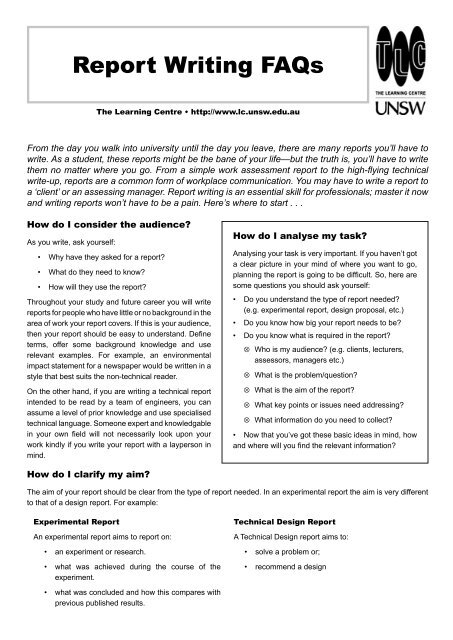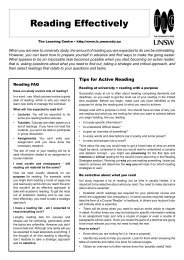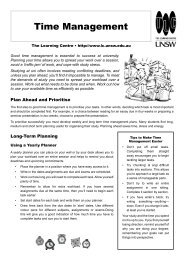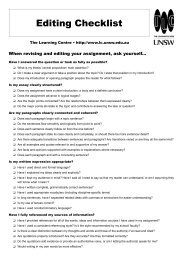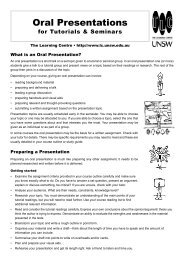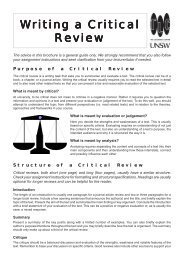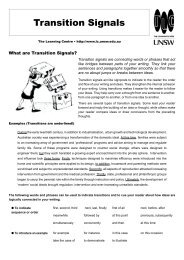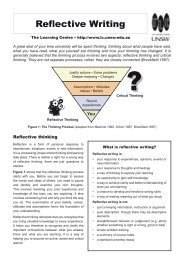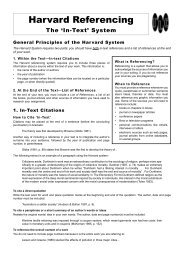Report Writing FAQs - The Learning Centre - University of New ...
Report Writing FAQs - The Learning Centre - University of New ...
Report Writing FAQs - The Learning Centre - University of New ...
You also want an ePaper? Increase the reach of your titles
YUMPU automatically turns print PDFs into web optimized ePapers that Google loves.
<strong>Report</strong> <strong>Writing</strong> <strong>FAQs</strong><br />
<strong>The</strong> <strong>Learning</strong> <strong>Centre</strong> • http://www.lc.unsw.edu.au<br />
From the day you walk into university until the day you leave, there are many reports you’ll have to<br />
write. As a student, these reports might be the bane <strong>of</strong> your life—but the truth is, you’ll have to write<br />
them no matter where you go. From a simple work assessment report to the high-flying technical<br />
write-up, reports are a common form <strong>of</strong> workplace communication. You may have to write a report to<br />
a ‘client’ or an assessing manager. <strong>Report</strong> writing is an essential skill for pr<strong>of</strong>essionals; master it now<br />
and writing reports won’t have to be a pain. Here’s where to start . . .<br />
How do I consider the audience?<br />
As you write, ask yourself:<br />
• Why have they asked for a report?<br />
• What do they need to know?<br />
• How will they use the report?<br />
Throughout your study and future career you will write<br />
reports for people who have little or no background in the<br />
area <strong>of</strong> work your report covers. If this is your audience,<br />
then your report should be easy to understand. Define<br />
terms, <strong>of</strong>fer some background knowledge and use<br />
relevant examples. For example, an environmental<br />
impact statement for a newspaper would be written in a<br />
style that best suits the non-technical reader.<br />
On the other hand, if you are writing a technical report<br />
intended to be read by a team <strong>of</strong> engineers, you can<br />
assume a level <strong>of</strong> prior knowledge and use specialised<br />
technical language. Someone expert and knowledgable<br />
in your own field will not necessarily look upon your<br />
work kindly if you write your report with a layperson in<br />
mind.<br />
How do I analyse my task?<br />
Analysing your task is very important. If you haven’t got<br />
a clear picture in your mind <strong>of</strong> where you want to go,<br />
planning the report is going to be difficult. So, here are<br />
some questions you should ask yourself:<br />
• Do you understand the type <strong>of</strong> report needed?<br />
(e.g. experimental report, design proposal, etc.)<br />
• Do you know how big your report needs to be?<br />
• Do you know what is required in the report?<br />
⊗ Who is my audience? (e.g. clients, lecturers,<br />
assessors, managers etc.)<br />
⊗ What is the problem/question?<br />
⊗ What is the aim <strong>of</strong> the report?<br />
⊗ What key points or issues need addressing?<br />
⊗ What information do you need to collect?<br />
• Now that you’ve got these basic ideas in mind, how<br />
and where will you find the relevant information?<br />
How do I clarify my aim?<br />
<strong>The</strong> aim <strong>of</strong> your report should be clear from the type <strong>of</strong> report needed. In an experimental report the aim is very different<br />
to that <strong>of</strong> a design report. For example:<br />
Experimental <strong>Report</strong><br />
An experimental report aims to report on:<br />
• an experiment or research.<br />
• what was achieved during the course <strong>of</strong> the<br />
experiment.<br />
Technical Design <strong>Report</strong><br />
A Technical Design report aims to:<br />
• solve a problem or;<br />
• recommend a design<br />
• what was concluded and how this compares with<br />
previous published results.
What is the Basic Structure <strong>of</strong> a <strong>Report</strong>?<br />
Types <strong>of</strong> reports can vary greatly; they can range from an experimental report to an environmental impact statement.<br />
<strong>The</strong>re is however, a basic structure common to most reports, irrespective <strong>of</strong> their type.<br />
<strong>The</strong> Major Components <strong>of</strong> a General <strong>Report</strong><br />
• Title Page<br />
• Abstract<br />
• Table <strong>of</strong> Contents<br />
• Introduction<br />
• Main Body<br />
• Conclusion<br />
• Recommendations<br />
• References<br />
• Appendices<br />
In less than 200 words ... what was the problem, how was it investigated,<br />
what did you find out and what do your findings mean?<br />
A list <strong>of</strong> the major and minor sections <strong>of</strong> your report.<br />
Set the scene; give some background information about the topic. State<br />
the aim/purpose <strong>of</strong> the investigation. Outline the body sections.<br />
Organise the sections in a logical sequence: what you investigated, what<br />
you found, what interpretations and what judgements you made. Use short<br />
informative headings and subheadings.<br />
What has been achieved and what is the significance <strong>of</strong> your findings and<br />
your discussion? Have your aims been successful or not?<br />
What do you recommend as a course <strong>of</strong> action following your conclusion?<br />
A list <strong>of</strong> all the sources you used.<br />
Any information (graphs, charts, tables or other data) you used in your<br />
report but did not include in the body.<br />
<strong>Writing</strong> Your <strong>Report</strong><br />
This section deals with the next step, writing the important sections <strong>of</strong> your report: the introduction,<br />
conclusion and abstract. <strong>The</strong>y are important because most readers will focus on these sections.<br />
Abstracts, Introductions & Conclusions—what’s the difference?<br />
An abstract is a brief statement which outlines the report in full; what was done, achieved, decided and concluded. <strong>The</strong><br />
introduction is a section which states your aims and some required background knowledge. An introduction will also<br />
outline the body <strong>of</strong> the report (where you state what you will do). Don’t confuse the introduction with the abstract or<br />
summary; they are NOT the same. <strong>The</strong> common misconception is that one is simply a smaller version <strong>of</strong> the other (that<br />
the introduction is a rewritten, chopped-up version <strong>of</strong> the abstract). However, this is not the case.<br />
<strong>The</strong> Abstract<br />
Most reports need an abstract, but they are generally more important for technical reports or scientific documents.<br />
• An abstract is a succinct passage which provides a brief outline on what was achieved/decided/concluded in your report.<br />
• An abstract is placed on a separate page before the contents page.<br />
• An abstract can be written last so that every bit <strong>of</strong> necessary detail is taken from the finished report.<br />
Abstract<br />
A trailer rig was used to analyse the properties <strong>of</strong> an undamped system and experiment<br />
with a range <strong>of</strong> instrumentation.<br />
It was found that two modes <strong>of</strong> vibration exist, these being longitudinal vibration<br />
and rotational. <strong>The</strong> damping ratio and natural frequency were calculated and are<br />
included in this report. <strong>The</strong> damping was found to be linear.<br />
While the experiment was useful it did not closely resemble road conditions. Actual<br />
road conditions would result in successive bumps and constant vibration while the<br />
wheels rotated the whole time.<br />
Finally, it was decided that given cost considerations, the XY plotter provided<br />
accurate results and manageable data.<br />
Setup/procedure<br />
Initial findings<br />
Conclusions<br />
Recommendations
• An abstract is one part <strong>of</strong> a report that will certainly be read by a client/assessor/manager. <strong>The</strong> rest <strong>of</strong> the report is<br />
read if more detail is required.<br />
• An abstract is about half a page in length. Sometimes a word limit is given. This can range from 50-300 words.<br />
<strong>The</strong> Introduction<br />
<strong>The</strong> aim <strong>of</strong> an introduction is to state what you have been asked to achieve and list your current course <strong>of</strong> action.<br />
Introduction<br />
This document compares a range<br />
<strong>of</strong> instrumentation <strong>of</strong> varying<br />
cost and sophistication and<br />
investigates the properties <strong>of</strong><br />
undamped systems.<br />
<strong>The</strong> natural frequency and damping<br />
ratio <strong>of</strong> these systems will give<br />
an indication <strong>of</strong> their behaviour<br />
when ‘excited’.<br />
Furthermore, an analysis <strong>of</strong> the<br />
mathematical model as compared<br />
to actual road conditions must<br />
be completed and equipment<br />
suggested for further studies<br />
<strong>of</strong> the trailer.<br />
Introduction<br />
Machinery and equipment in<br />
industry is heated up and<br />
brought on line gradually to<br />
avoid problems generated by<br />
thermal generated stresses. In<br />
this experiment the severity <strong>of</strong><br />
stress due to sudden temperature<br />
changes are examined.<br />
Purpose<br />
Aim; part <strong>of</strong> a<br />
major report.<br />
Requires an<br />
outline <strong>of</strong> the<br />
steps you<br />
will take.<br />
Background<br />
Aim; it is not<br />
necessary to<br />
outline everything<br />
in a short or<br />
introductory<br />
report. Be<br />
succinct!<br />
<strong>The</strong> Conclusion<br />
<strong>The</strong> conclusion (along with the introduction and abstract) is generally the section most read by clients. If you can conclude<br />
your work /findings well, you facilitate your client’s understanding <strong>of</strong> your work’s significance, your achievements and<br />
whether your aims have been successful or not. Even in the face <strong>of</strong> failure, e.g. your experiments do not work, a proper<br />
conclusion would demonstrate an understanding <strong>of</strong> what you achieved. Here is how to do that:<br />
• Note the shortcomings and pitfalls <strong>of</strong> the methods and/or equipment used<br />
• State your findings from the analysis <strong>of</strong> your data<br />
• Outline possible recommendations (e.g. provide suggestions for further research).<br />
Recommendations may form a separate heading if substantial.<br />
A Note <strong>of</strong> Caution:<br />
Do not use your abstract to write your conclusion or vice versa as the reader will believe you have not put enough thought<br />
into why you are doing your work. Remember the abstract, introduction and conclusion have different purposes, different<br />
emphasis and different structures.<br />
Conclusion<br />
<strong>The</strong> results <strong>of</strong> the damping coefficient and the natural frequency <strong>of</strong> the system are<br />
fairly consistent given the small amount <strong>of</strong> data given and how prone this method is<br />
to error.<br />
Findings & what was<br />
achieved<br />
In looking at the data provided by the pointer and scale it is surprising that the<br />
results were so consistent. <strong>The</strong> equipment was difficult to use and read and not really<br />
adequate for this type <strong>of</strong> testing.<br />
<strong>The</strong> LVDT transducer provided clear results for the XY plotter and the digital<br />
oscilloscope, both providing graphs that were very clear. I recommend the use <strong>of</strong> the<br />
XY plotter over the digital oscilloscope due to their difference in price ($4000 for<br />
a XY plotter and $7000 for a digital oscilloscope). <strong>The</strong> XY plotter does not require<br />
the use <strong>of</strong> a computer and printer to get it into a hard copy form where the data<br />
can be analysed.<br />
Recommendations
How should I present my report?<br />
• READ assignment guidelines in your course outlines. Reading these instructions will inevitably save you hours in<br />
that final effort to finish the report.<br />
• Impress your marker by making it look like a pr<strong>of</strong>essional report. You can do this easily because many word<br />
processing programs have a report template you can use or adapt.<br />
• Type your report; it makes your work easier to read. Calculations can be done by hand, but adhere to the following<br />
guidelines:<br />
⊗ Rule up your page. Put answers to all your calculations in a right hand column. This stops the reader from<br />
having to search your page for them.<br />
⊗ Double space your work. Don't squash visuals and text together.<br />
• Everything must be geared towards making it easy for your readers. See our brochure on Technical <strong>Writing</strong> for<br />
additional advice on language and layout <strong>of</strong> reports.<br />
• Look at past reports. <strong>The</strong> library has thesis reports (hard copy and online) in the collection. Your school also has<br />
4th year honours thesis reports and Masters and PhD thesis reports.<br />
Remember, keep it simple!<br />
1. What was the original request? Does your work fulfil the<br />
requirements?<br />
2. What does the audience need/want from your report? Have<br />
you included it?<br />
3. When editing your report, retain what is important/ relevant,<br />
delete what is not.<br />
4. Is there much repetition? Can you merge or delete<br />
sections?<br />
5. Do your conclusions come from your findings and not from<br />
generalisations? (See example opposite).<br />
Example Conclusions. . .<br />
Three academics are travelling on a train<br />
through Britain. As the train crosses into<br />
Scotland they see a black sheep in a field.<br />
<strong>The</strong> first academic remarks “Oh look, the<br />
sheep in Scotland are black”.<br />
<strong>The</strong> second academic replies “No, some<br />
sheep in Scotland are black”.<br />
<strong>The</strong> third academic declares “<strong>The</strong>re is at<br />
least one sheep in Scotland that is black on<br />
at least one side”.<br />
Need to know more?<br />
IF ALL ELSE FAILS, revisit your original task analysis and TALK TO YOUR ‘CLIENT’ (lecturer, tutor, marker etc.) and<br />
clarify what they want in the report.<br />
Prepared by Prepared by Pam Mort, Johann Idriss, Tracey-Lee Downey & Pradeep Sharma for <strong>The</strong> <strong>Learning</strong> <strong>Centre</strong>,<br />
<strong>The</strong> <strong>University</strong> <strong>of</strong> <strong>New</strong> South Wales © 2009. This guide may be distributed for educational purposes, and the content<br />
may be adapted with proper acknowledgement. <strong>The</strong> document itself must not be digitally altered or rebranded. Email:<br />
learningcentre@unsw.edu.au


